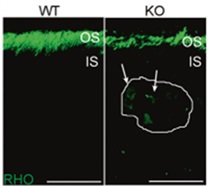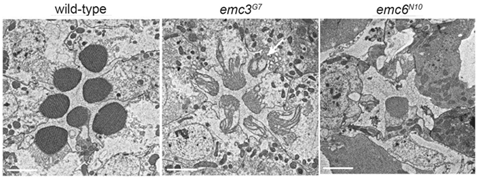On July 1st, 2019, Dr. Tao Wang’s lab has published an article on the journal of 《Cell Death and Differentiation》which is titled “ER complex proteins are required for rhodopsin biosynthesis and photoreceptor survival in Drosophila and mice”. The author reported ER membrane complex (EMC) plays an important role in Rhodopsin synthesis and photoreceptor survival both inDrosophilaand mice.
Retinitis Pigmentosa (RP) is a common hereditary progressive retinal degeneration disease, which affects 1 out of 3500 people. RP will eventually lead to blindness due to a gradually loss of cone cells, and no effective clinical treatment available so far. Mutations in Rhodopsin gene account for 25% of all the autosomal dominant RP cases. Thus, a better understanding of how Rhodopsin is regulated offers an opportunity to cure related RP diseases.
In this paper, the author isolated three independentemcmutants via a large-scale EMS screening. EMC, composed of ten subunits, is a highly conserved ER transmembrane protein complex, and functions in varied processes such as autophagy, viral infection, lung development and lipid transportation. AlthoughEMC1mutation has been identified in retinal degenerated patients, we still don’t know how EMC functions in mammalian visual system, nor do we know the way EMC regulates its substrates and different functions within EMC subunits.
The author found,emcmutants displayed decreased Rhodopsin protein level and absence of prolonged depolarization afterpotential (PDA). And EMC regulates Rhodopsin level through protein biosynthesis step rather than degradation process. TEM pictures show a retinal degeneration phenotype inemcmutant flies.


(Figure 1 Left: Rhodopsin decreased inemcmutant flies, Right: Rhodopsin decreased and mislocalized inEmc3 KO mice.)

(Figure 2 Loss of PDA inemcmutant flies.)

(Figure 3 Retinal degeneration inemcmutant flies.)
Next, the author generated a whole library ofemcknockout flies and measured the importance of each EMC subunit in different context, ranging from animal viability, cellular viability, rhodopsin levels, and phototransduction. Also, based on proteomic analysis, the author claimed that different EMC subunits show discrepancy towards substrate selection, and thus might function differently in cells.
Finally, the author confirmed the importance of EMC in regulating Rhodopsin level and maintaining photoreceptor structure in mice. Knocking outEmc3in photoreceptors leads to a decreased and mislocalized Rhodopsin protein, as well as degenerated photoreceptors, proving the conserved role of EMC in mammals.
This study established a conserved role for EMC to function in regulating Rhodopsin level and maintaining photoreceptor structure in bothDrosophilaand mice, and might provide a new solution for interfering retinitis pigmentosa.
Liangyao Xiong (2014 PTN project) from Dr. Tao Wang’s lab and Dr. Lin Zhang from Dr. Xianjun Zhu’s lab in Sichuan Provincial People’s Hospital are the co-first authors of this paper. Other contributors include Yeming Yang and Na Li (Dr. Xianjun Zhu’s lab), Dr. Wenjia Lai from National Center for Nanoscience and Technology, and Dr. Fengchao Wang from TIMBR/NIBS. Dr. Xianjun Zhu and Dr. Tao Wang are the co-corresponding authors of this paper. This study is supported by National Natural Science Foundation of China, National Key Scientific Research Program and Department of Science and Technology of Sichuan Province.